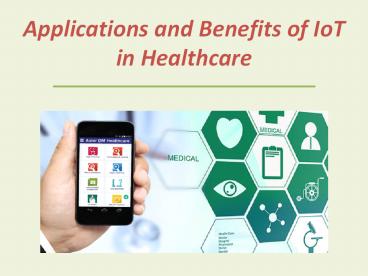Applications and Benefits of IoT in Healthcare - PowerPoint PPT Presentation
Title:
Applications and Benefits of IoT in Healthcare
Description:
Garner the benefits of IoT for your healthcare institution! To get a secure and cost-effective solution entrust any software development specialist. – PowerPoint PPT presentation
Number of Views:6065
Title: Applications and Benefits of IoT in Healthcare
1
Applications and Benefits of IoT in Healthcare
2
Internet of Things (IoT) is intended to minimize
or completely eliminate interactions between
human beings or between human beings and
computers.
Most hospitals have improved diagnosis, reduced
operating costs and increased life expectancy of
patients by achieving a higher level of
automation and convenience through the use of
connected wristbands in patients, beds and
beacons in and outside the hospital premises.
3
We discuss few benefits of IoT in healthcare as
given below
1. Diagnosis is next level
2. Treatment is improved
3. Cost is minimized
4
1. Diagnosis is next level
The capability of computers to absorb more data
in less time is making it more appropriate for
the healthcare sector.
If doctors want to keep themselves updated with
the latest news of the medical world then they
would have to read articles, case studies and
reports and there wont be much time left for
them to do their actual work.
5
But IBMs Watson, on the other hand, gathers data
from patient records, case studies from all
around the world and then makes decision through
Artificial Intelligence. Hence, with 90 accuracy
it is far better than doctors (50 accuracy) at
diagnosing cancer.
6
2. Treatment is improved
Patients with chronic ailments like diabetes,
hypertension and congestive heart failure, if
maintain 80-100 on time medication schedule then
they have 17 less need of hospitalization than
those who miss to take prescribed medications.
7
Smart medication dispensers like MedMinder (pill
container that has built-in cellular connection
that sends alert notifications when patients
forget to take pills or it requires refilling),
GlowPack (an audio-visual pill reminder that
generates weekly and monthly medication adherence
report for doctors to evaluate outcome of
treatment) and AdhereTech (smart bottles that
gives patients a call each time they miss their
medication) can come to the rescue of such
patients, especially the elderly ones, and can
significantly reduce hospitalization rates and
give better treatment to patients with such
chronic diseases.
8
3. Cost is minimized
As discussed in the above point most of the
readmissions come from patients with chronic
diseases when they miss their medication schedule.
For instance, diabetes is a chronic disease and
it care mostly depends on self-management. Hence,
most medical institutions can potentially avoid
readmissions of such patients by adopting IoT
technologies that we have just discussed in
previous point.
9
Moreover, smart beds connected with movement
sensors, wearable devices and monitors will
facilitate remote monitoring of elderly patients
with real-time data from their homes.
Originally Posted On- http//goo.gl/e664CN
10
Interested To Know More About?
Outsource Web Entwicklung
Web Entwicklung Spezialist
Website Entwicklung































